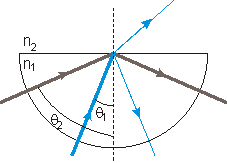Total internal reflection
|
|
Total_internal_reflection.jpg
Total internal reflection is an optical phenomenon. It occurs when light is refracted (bent) at a medium boundary enough to send it backwards, effectively reflecting the entire ray.
When light crosses materials with different refractive indices, the light beam will be partially refracted at the boundary surface, and partially reflected. However, if the angle of incidence is shallower (closer to the boundary) than the critical angle, the angle of incidence where light is refracted so that it travels along the boundary, then the light will stop crossing the boundary altogether and instead totally reflect back internally. This can only occur where light travels from a denser medium to a less dense medium, that is, from the medium with the higher refractive index. For example, it will occur when passing from glass to air, but not when passing from air to glass.
Total internal reflection can be demonstrated using a semi-circular glass block. A ray box shines a light ray onto the glass. The semi-circular shape ensures that a ray pointing towards the center of the flat face will hit the surface at right angles. This prevents refraction at the air/glass boundary.
At the glass/air boundary what happens will depend on the angle. Where θc is the critical angle:
- If θ < θc, as with the blue ray, the ray will split. Some of the ray will reflect off the boundary, and some will refract as it passes through.
- If θ > θc, as with the grey ray, all of the ray reflects from the boundary. None passes through.
The second situation is total internal reflection.
This physical property makes optical fibres useful, and rainbows and prismatic binoculars possible. It is also what gives diamonds their distinctive sparkle, as diamond has an extremely high refractive index.
An important side effect of total internal reflection is the propagation of an evanescent wave across the boundary surface.

